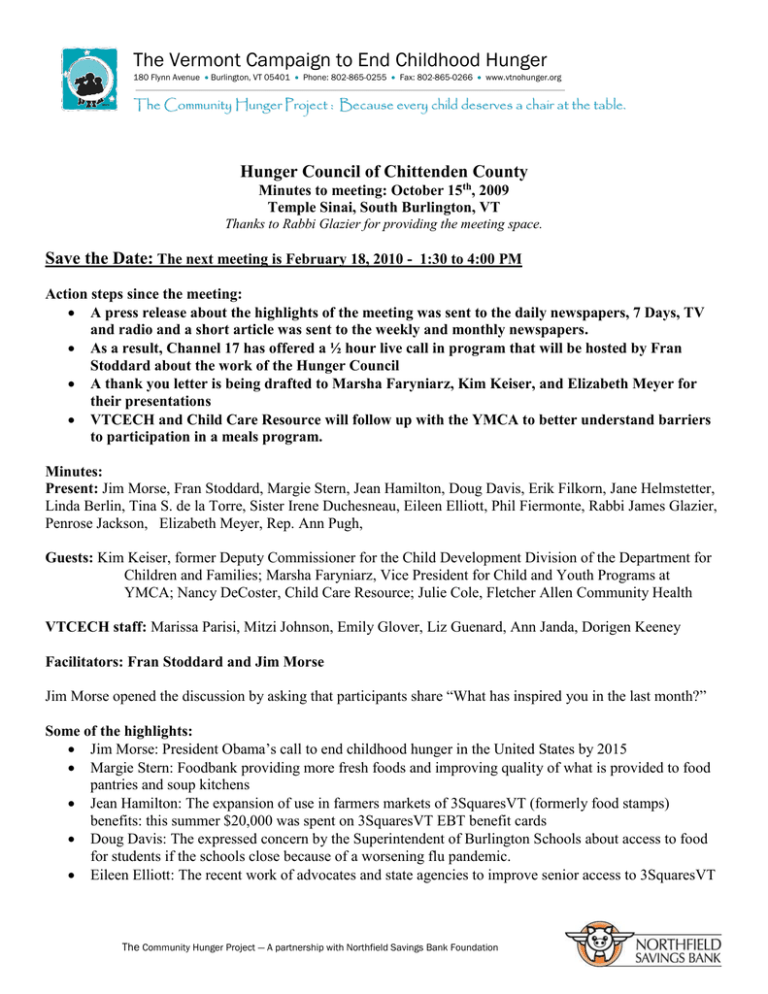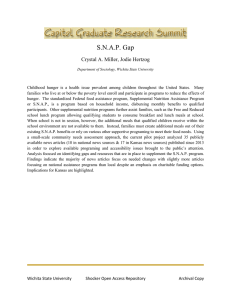October 15, 2009 - Hunger Free Vermont
advertisement

The Vermont Campaign to End Childhood Hunger 180 Flynn Avenue Burlington, VT 05401 Phone: 802-865-0255 Fax: 802-865-0266 www.vtnohunger.org The Community Hunger Project : Because every child deserves a chair at the table. Hunger Council of Chittenden County Minutes to meeting: October 15th, 2009 Temple Sinai, South Burlington, VT Thanks to Rabbi Glazier for providing the meeting space. Save the Date: The next meeting is February 18, 2010 - 1:30 to 4:00 PM Action steps since the meeting: A press release about the highlights of the meeting was sent to the daily newspapers, 7 Days, TV and radio and a short article was sent to the weekly and monthly newspapers. As a result, Channel 17 has offered a ½ hour live call in program that will be hosted by Fran Stoddard about the work of the Hunger Council A thank you letter is being drafted to Marsha Faryniarz, Kim Keiser, and Elizabeth Meyer for their presentations VTCECH and Child Care Resource will follow up with the YMCA to better understand barriers to participation in a meals program. Minutes: Present: Jim Morse, Fran Stoddard, Margie Stern, Jean Hamilton, Doug Davis, Erik Filkorn, Jane Helmstetter, Linda Berlin, Tina S. de la Torre, Sister Irene Duchesneau, Eileen Elliott, Phil Fiermonte, Rabbi James Glazier, Penrose Jackson, Elizabeth Meyer, Rep. Ann Pugh, Guests: Kim Keiser, former Deputy Commissioner for the Child Development Division of the Department for Children and Families; Marsha Faryniarz, Vice President for Child and Youth Programs at YMCA; Nancy DeCoster, Child Care Resource; Julie Cole, Fletcher Allen Community Health VTCECH staff: Marissa Parisi, Mitzi Johnson, Emily Glover, Liz Guenard, Ann Janda, Dorigen Keeney Facilitators: Fran Stoddard and Jim Morse Jim Morse opened the discussion by asking that participants share “What has inspired you in the last month?” Some of the highlights: Jim Morse: President Obama’s call to end childhood hunger in the United States by 2015 Margie Stern: Foodbank providing more fresh foods and improving quality of what is provided to food pantries and soup kitchens Jean Hamilton: The expansion of use in farmers markets of 3SquaresVT (formerly food stamps) benefits: this summer $20,000 was spent on 3SquaresVT EBT benefit cards Doug Davis: The expressed concern by the Superintendent of Burlington Schools about access to food for students if the schools close because of a worsening flu pandemic. Eileen Elliott: The recent work of advocates and state agencies to improve senior access to 3SquaresVT The Community Hunger Project — A partnership with Northfield Savings Bank Foundation The Vermont Campaign to End Childhood Hunger 180 Flynn Avenue Burlington, VT 05401 Phone: 802-865-0255 Fax: 802-865-0266 www.vtnohunger.org The Community Hunger Project : Because every child deserves a chair at the table. Jane Helmstetter: Recent changes in the WIC program that increase fruits, vegetables, whole grains and the use of alternative proteins like tofu Sister Irene: Especially concerned about reaching the elderly, who are so isolated and hard to reach Elizabeth Meyer: Inspired by individuals’ commitments to helping others: relayed that a child care provider will be the sole caretaker of a child because the single parent was being deployed to Afghanistan Penrose Jackson: Inspired and frustrated by recent recovery money coming into the state to fund programs that improve physical activity and nutrition that are focused on obesity rather than on nutrition Phil Fiermonte: Inspired by Senator Sanders’ recent proposal for $250 payment to seniors in lieu of COLA increase this year in Social Security. Also, amendment to Ag appropriations bill to aid dairy farmers, both indirect and direct support to farmers James Glazier: His congregation collected over a ton of food for local food pantries and the social action committee is committed to deliver meals-on-wheels throughout the year rather than just once a year on Christmas Panel on feeding young children: Kim Keiser provided a history of Building Bright Futures, a coordinated and holistic approach to supporting young children and their families in communities. BBF began in late 1980’s when regional councils were formed informally and then more formally in the early 1990’s. The goal was to bring health, early education, mental health, hunger, nutrition services, and child care providers together into a common forum to know what one another were doing and to begin to develop together some strategies on targeted goals. The three stated outcomes were: 1. Pregnant women and children thrive; 2. Children live in stable and secure families; 3. Children are ready for school. The work was based on a growing scientific literature on what creates the best outcomes for children. Recently regional capacity has been severely diminished because positions have been cut. She is concerned that equity of access to services, including nutrition, has not been a priority and more rural counties are losing out. She encourages the Council to closely align their work with BBF and to help ensure that the vision not be compromised. Elizabeth Meyer: She provided an update on Child Care Resource’s project to increase the number of child care centers providing meals to all children through the child care food program in Chittenden County. The first center, Muddy Hands, was enrolled in November 2008 and another 5 centers were added over the year. The programs are primarily serving breakfast and pm snack because it is more difficult to provide lunch, which takes more time, facilities, and money. Three additional programs are slated to come on, serving an average of 173 children. They are finding that some of the barriers are insufficient facilities, funds to cover staffing/labor costs, paperwork tracking, time limitations, and parents preferring to bring their own meals and snack. They are exploring a bulk buying program through the Vermont Foodbank to reduce food costs for programs. Marsha Faryniarz: The YMCA runs 8 child care centers and 22 afterschool programs. Many do not have kitchen facilities, although meals could be brought in from other programs. The YMCA asks that parents send meals in with the children and provide snack to the whole class on a rotating basis. The YMCA does not see the The Community Hunger Project — A partnership with Northfield Savings Bank Foundation The Vermont Campaign to End Childhood Hunger 180 Flynn Avenue Burlington, VT 05401 Phone: 802-865-0255 Fax: 802-865-0266 www.vtnohunger.org The Community Hunger Project : Because every child deserves a chair at the table. need for the meal program because kids are not bringing in poor quality meals and snacks. If a child does come in with poor quality food the staff provides information to the parents on better food choices. The biggest obstacle to providing meals and snacks is extra time that it would take to prepare the food and do the paperwork. Mitzi Johnson: Vermont ranks 49th in the country in providing meals in child care centers. Several years ago, VTCECH surveyed all the child care centers in Vermont to identify why providers/centers were not participating. The barriers identified were lack of information on the program, too much paperwork, and lack of facilities. VTCECH has been working on reducing these barriers including replicating the sponsorship model (like Child Care Resource) in other parts of the state whereby an agency does most of the paperwork for the centers. In addition, VTCECH in conjunction with Department of Education has reduced the length of the application dramatically, from 45 pages to 9 pages. Mitzi has also developed electronic spreadsheets for centers to use that reduce the time needed by 2/3rds. VT Works for Women is investigating the possibility of a catered meals program for centers that do not have kitchen facilities or staff time and combining it with a jobs training program. In a year, we have enrolled enough centers on the program such that there is another $310,000 annually coming in to the state ($155,000 of that in Chittenden County) to feed children just from centers newly enrolled. Centers that begin to participate in the meals program have found that preparing 1 meal for 30 children is actually faster than heating up 30 different lunches. Centers also report that the behavior of children is improved and in one case, the child’s behavior was so dramatically improved that he no longer needed a 1-on-1 aide when he was getting adequate meals at the center. Highlights of the discussion: Council members wondered if the YMCA has done any kinds of surveys of the families to learn a little bit about their experience with their ability to send lunch or what their wishes would be concerning meals. 15-20% of the children who attend the YMCA centers receive a state subsidy. The child care food program has a strong component of nutrition education for parents and providers School-based programs can provide afterschool snack through the school lunch program with almost no paperwork. Vermont has low participation, in part, because we have smaller centers and relatively low reimbursement for the meals because poverty is spread out geographically (the reimbursement per meal is based on the % of low-income children in the center). Burlington Schools are working to provide culturally familiar foods for the many new immigrants to Burlington (52 languages are spoken at Burlington High School). The new immigrant students want “American” food, while the “American” students want to try the new immigrant foods. CACFP provides education to the family through the children bringing home the desire for family style meals and a variety of new foods, especially fruits and vegetables. Providing meals does gain a center points in the Vermont system for measuring quality, the “Stars” program The Community Hunger Project — A partnership with Northfield Savings Bank Foundation The Vermont Campaign to End Childhood Hunger 180 Flynn Avenue Burlington, VT 05401 Phone: 802-865-0255 Fax: 802-865-0266 www.vtnohunger.org The Community Hunger Project : Because every child deserves a chair at the table. The Commodity program needs to be reformed such that local products could be purchased. VT legislature could help reform the commodity program to allow the purchase of local products. Next Meeting: February 18th, 2010, 1:30-4:00 pm. At Temple Sinai Respectfully submitted by Jonathan Harris and Dorigen Keeney The Community Hunger Project — A partnership with Northfield Savings Bank Foundation

